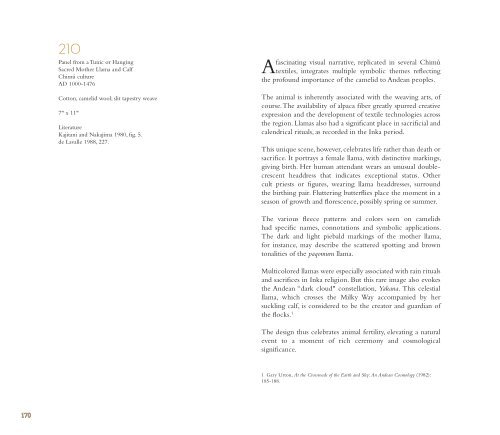Create successful ePaper yourself
Turn your PDF publications into a flip-book with our unique Google optimized e-Paper software.
210<br />
Panel from a Tunic or Hanging<br />
Sacred Mo<strong>the</strong>r Llama and Calf<br />
Chimú culture<br />
AD 1000-1476<br />
Cotton, camelid wool; slit tapestry weave<br />
7" x 11"<br />
Literature<br />
Kajitani and Nakajima 1980, fig. 5.<br />
de Lavalle 1988, 227.<br />
A<br />
fascinating visual narrative, replicated in several Chimú<br />
textiles, integrates multiple symbolic <strong>the</strong>mes reflecting<br />
<strong>the</strong> profound importance of <strong>the</strong> camelid to Andean peoples.<br />
The animal is inherently associated with <strong>the</strong> weaving arts, of<br />
course. The availability of alpaca fiber greatly spurred creative<br />
expression and <strong>the</strong> development of textile technologies across<br />
<strong>the</strong> region. Llamas also had a significant place in sacrificial and<br />
calendrical rituals, as recorded in <strong>the</strong> Inka period.<br />
This unique scene, however, celebrates life ra<strong>the</strong>r than death or<br />
sacrifice. It portrays a female llama, with distinctive markings,<br />
giving birth. Her human attendant wears an unusual doublecrescent<br />
headdress that indicates exceptional status. O<strong>the</strong>r<br />
cult priests or figures, wearing llama headdresses, surround<br />
<strong>the</strong> birthing pair. Fluttering butterflies place <strong>the</strong> moment in a<br />
season of growth and florescence, possibly spring or summer.<br />
The various fleece patterns and colors seen on camelids<br />
had specific names, connotations and symbolic applications.<br />
The dark and light piebald markings of <strong>the</strong> mo<strong>the</strong>r llama,<br />
for instance, may describe <strong>the</strong> scattered spotting and brown<br />
tonalities of <strong>the</strong> paqomuru llama.<br />
Multicolored llamas were especially associated with rain rituals<br />
and sacrifices in Inka religion. But this rare image also evokes<br />
<strong>the</strong> Andean “dark cloud" constellation, Yakana. This celestial<br />
llama, which crosses <strong>the</strong> Milky Way accompanied by her<br />
suckling calf, is considered to be <strong>the</strong> creator and guardian of<br />
<strong>the</strong> flocks. 1<br />
The design thus celebrates animal fertility, elevating a natural<br />
event to a moment of rich ceremony and cosmological<br />
significance.<br />
1 Gary Urton, At <strong>the</strong> Crossroads of <strong>the</strong> Earth and Sky: An Andean Cosmology (1982):<br />
185-188.<br />
170







